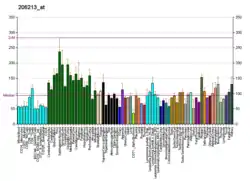WNT10B
Protein Wnt-10b (formerly Wnt12[5]) is a protein that in humans is encoded by the WNT10B gene.[6][7][8][9]
The WNT gene family consists of structurally related genes that encode secreted signaling proteins. These proteins have been implicated in oncogenesis and in several developmental processes, including regulation of cell fate and patterning during embryogenesis.
This gene is a member of the WNT gene family. It may be involved in breast cancer, and its protein signaling is, it is presumed, a molecular switch that governs adipogenesis. Gain-of-function of Wnt10b in mouse hearts has shown to improve cardiac tissue repair after myocardial injury, by promoting coronary vessel formation and attenuating pathological fibrosis.[10] This protein is 96% identical to the mouse Wnt10b protein at the amino acid level. This gene is clustered with another family member, WNT1, in the chromosome 12q13 region.[9]
References
- GRCh38: Ensembl release 89: ENSG00000169884 - Ensembl, May 2017
- GRCm38: Ensembl release 89: ENSMUSG00000022996 - Ensembl, May 2017
- "Human PubMed Reference:". National Center for Biotechnology Information, U.S. National Library of Medicine.
- "Mouse PubMed Reference:". National Center for Biotechnology Information, U.S. National Library of Medicine.
- Schubert M, Holland LZ, Holland ND, Jacobs DK (2000). "A phylogenetic tree of the Wnt genes based on all available full-length sequences, including five from the cephalochordate amphioxus". Molecular Biology and Evolution. 17 (12): 1896–903. doi:10.1093/oxfordjournals.molbev.a026291. PMID 11110906.
- Bui TD, Rankin J, Smith K, Huguet EL, Ruben S, Strachan T, Harris AL, Lindsay S (Apr 1997). "A novel human Wnt gene, WNT10B, maps to 12q13 and is expressed in human breast carcinomas". Oncogene. 14 (10): 1249–53. doi:10.1038/sj.onc.1200936. PMID 9121776.
- Hardiman G, Kastelein RA, Bazan JF (Sep 1997). "Isolation, characterization and chromosomal localization of human WNT10B". Cytogenet Cell Genet. 77 (3–4): 278–82. doi:10.1159/000134597. PMID 9284937.
- Ugur SA, Tolun A (Aug 2008). "Homozygous WNT10b mutation and complex inheritance in Split-Hand/Foot Malformation". Hum Mol Genet. 17 (17): 2644–53. doi:10.1093/hmg/ddn164. PMID 18515319.
- "Entrez Gene: WNT10B wingless-type MMTV integration site family, member 10B".
- Paik DT, Rai M, Ryzhov S, Sanders LN, Aisagbonhi O, Funke MJ, Feoktistov I, Hatzopoulos AK. Wnt10b gain-of-function improves cardiac repair by arteriole formation and attenuation of fibrosis. Circ Res. 2015; 117:804-816.
Further reading
- Smolich BD, McMahon JA, McMahon AP, Papkoff J (1994). "Wnt family proteins are secreted and associated with the cell surface". Mol. Biol. Cell. 4 (12): 1267–75. doi:10.1091/mbc.4.12.1267. PMC 275763. PMID 8167409.
- Bergstein I, Eisenberg LM, Bhalerao J, et al. (1998). "Isolation of two novel WNT genes, WNT14 and WNT15, one of which (WNT15) is closely linked to WNT3 on human chromosome 17q21". Genomics. 46 (3): 450–8. doi:10.1006/geno.1997.5041. PMID 9441749.
- Ross SE, Hemati N, Longo KA, et al. (2000). "Inhibition of adipogenesis by Wnt signaling". Science. 289 (5481): 950–3. doi:10.1126/science.289.5481.950. PMID 10937998.
- Kirikoshi H, Sekihara H, Katoh M (2001). "WNT10A and WNT6, clustered in human chromosome 2q35 region with head-to-tail manner, are strongly coexpressed in SW480 cells". Biochem. Biophys. Res. Commun. 283 (4): 798–805. doi:10.1006/bbrc.2001.4855. PMID 11350055.
- Saitoh T, Kirikoshi H, Mine T, Katoh M (2002). "Proto-oncogene WNT10B is up-regulated by tumor necrosis factor alpha in human gastric cancer cell line MKN45". Int. J. Oncol. 19 (6): 1187–92. doi:10.3892/ijo.19.6.1187. PMID 11713588.
- Kasat K, Go V, Pogo BG (2003). "Effects of pyrethroid insecticides and estrogen on WNT10B proto-oncogene expression". Environment International. 28 (5): 429–32. doi:10.1016/S0160-4120(02)00072-7. PMID 12437293.
- Strausberg RL, Feingold EA, Grouse LH, et al. (2003). "Generation and initial analysis of more than 15,000 full-length human and mouse cDNA sequences". Proc. Natl. Acad. Sci. U.S.A. 99 (26): 16899–903. doi:10.1073/pnas.242603899. PMC 139241. PMID 12477932.
- Gerhard DS, Wagner L, Feingold EA, et al. (2004). "The Status, Quality, and Expansion of the NIH Full-Length cDNA Project: The Mammalian Gene Collection (MGC)". Genome Res. 14 (10B): 2121–7. doi:10.1101/gr.2596504. PMC 528928. PMID 15489334.
- Christodoulides C, Scarda A, Granzotto M, et al. (2006). "WNT10B mutations in human obesity". Diabetologia. 49 (4): 678–84. doi:10.1007/s00125-006-0144-4. PMC 4304000. PMID 16477437.
- Thrasivoulou C, Millar M, Ahmed A (2013). "Activation of intracellular calcium by multiple Wnt ligands and translocation of ß-catenin into the nucleus: a convergent model of Wnt/Ca2+ and Wnt/ß-catenin pathways". J. Biol. Chem. 288 (50): 35651–35659. doi:10.1074/jbc.M112.437913. PMC 3861617. PMID 24158438.




